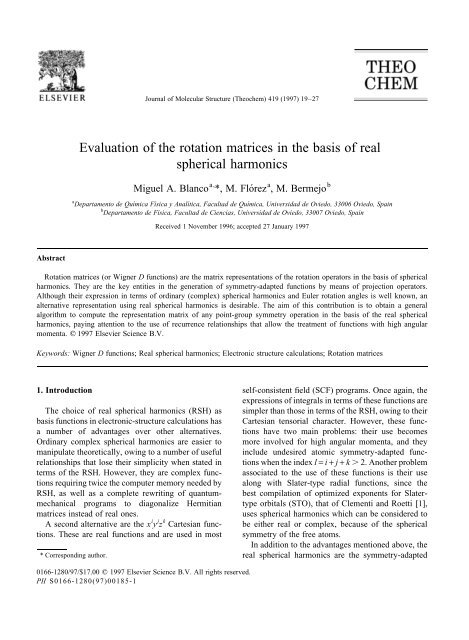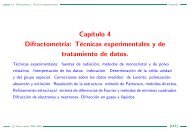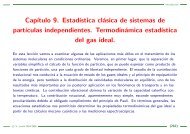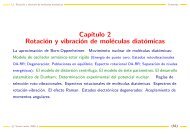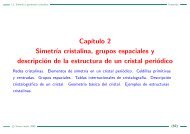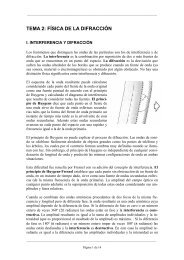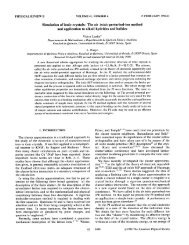Evaluation of the rotation matrices in the basis of real spherical ...
Evaluation of the rotation matrices in the basis of real spherical ...
Evaluation of the rotation matrices in the basis of real spherical ...
You also want an ePaper? Increase the reach of your titles
YUMPU automatically turns print PDFs into web optimized ePapers that Google loves.
Abstract<br />
<strong>Evaluation</strong> <strong>of</strong> <strong>the</strong> <strong>rotation</strong> <strong>matrices</strong> <strong>in</strong> <strong>the</strong> <strong>basis</strong> <strong>of</strong> <strong>real</strong><br />
<strong>spherical</strong> harmonics<br />
Miguel A. Blanco a, *, M. Flórez a , M. Bermejo b<br />
a Departamento de Química Física y Analítica, Facultad de Química, Universidad de Oviedo, 33006 Oviedo, Spa<strong>in</strong><br />
b Departamento de Física, Facultad de Ciencias, Universidad de Oviedo, 33007 Oviedo, Spa<strong>in</strong><br />
Received 1 November 1996; accepted 27 January 1997<br />
Rotation <strong>matrices</strong> (or Wigner D functions) are <strong>the</strong> matrix representations <strong>of</strong> <strong>the</strong> <strong>rotation</strong> operators <strong>in</strong> <strong>the</strong> <strong>basis</strong> <strong>of</strong> <strong>spherical</strong><br />
harmonics. They are <strong>the</strong> key entities <strong>in</strong> <strong>the</strong> generation <strong>of</strong> symmetry-adapted functions by means <strong>of</strong> projection operators.<br />
Although <strong>the</strong>ir expression <strong>in</strong> terms <strong>of</strong> ord<strong>in</strong>ary (complex) <strong>spherical</strong> harmonics and Euler <strong>rotation</strong> angles is well known, an<br />
alternative representation us<strong>in</strong>g <strong>real</strong> <strong>spherical</strong> harmonics is desirable. The aim <strong>of</strong> this contribution is to obta<strong>in</strong> a general<br />
algorithm to compute <strong>the</strong> representation matrix <strong>of</strong> any po<strong>in</strong>t-group symmetry operation <strong>in</strong> <strong>the</strong> <strong>basis</strong> <strong>of</strong> <strong>the</strong> <strong>real</strong> <strong>spherical</strong><br />
harmonics, pay<strong>in</strong>g attention to <strong>the</strong> use <strong>of</strong> recurrence relationships that allow <strong>the</strong> treatment <strong>of</strong> functions with high angular<br />
momenta. 1997 Elsevier Science B.V.<br />
Keywords: Wigner D functions; Real <strong>spherical</strong> harmonics; Electronic structure calculations; Rotation <strong>matrices</strong><br />
1. Introduction<br />
The choice <strong>of</strong> <strong>real</strong> <strong>spherical</strong> harmonics (RSH) as<br />
<strong>basis</strong> functions <strong>in</strong> electronic-structure calculations has<br />
a number <strong>of</strong> advantages over o<strong>the</strong>r alternatives.<br />
Ord<strong>in</strong>ary complex <strong>spherical</strong> harmonics are easier to<br />
manipulate <strong>the</strong>oretically, ow<strong>in</strong>g to a number <strong>of</strong> useful<br />
relationships that lose <strong>the</strong>ir simplicity when stated <strong>in</strong><br />
terms <strong>of</strong> <strong>the</strong> RSH. However, <strong>the</strong>y are complex functions<br />
requir<strong>in</strong>g twice <strong>the</strong> computer memory needed by<br />
RSH, as well as a complete rewrit<strong>in</strong>g <strong>of</strong> quantummechanical<br />
programs to diagonalize Hermitian<br />
<strong>matrices</strong> <strong>in</strong>stead <strong>of</strong> <strong>real</strong> ones.<br />
A second alternative are <strong>the</strong> x i y j z k Cartesian functions.<br />
These are <strong>real</strong> functions and are used <strong>in</strong> most<br />
* Correspond<strong>in</strong>g author.<br />
THEOCH 5216<br />
Journal <strong>of</strong> Molecular Structure (Theochem) 419 (1997) 19–27<br />
0166-1280/97/$17.00 1997 Elsevier Science B.V. All rights reserved.<br />
PII S0166-1280(97)00185-1<br />
self-consistent field (SCF) programs. Once aga<strong>in</strong>, <strong>the</strong><br />
expressions <strong>of</strong> <strong>in</strong>tegrals <strong>in</strong> terms <strong>of</strong> <strong>the</strong>se functions are<br />
simpler than those <strong>in</strong> terms <strong>of</strong> <strong>the</strong> RSH, ow<strong>in</strong>g to <strong>the</strong>ir<br />
Cartesian tensorial character. However, <strong>the</strong>se functions<br />
have two ma<strong>in</strong> problems: <strong>the</strong>ir use becomes<br />
more <strong>in</strong>volved for high angular momenta, and <strong>the</strong>y<br />
<strong>in</strong>clude undesired atomic symmetry-adapted functions<br />
when <strong>the</strong> <strong>in</strong>dex l = i + j + k 2. Ano<strong>the</strong>r problem<br />
associated to <strong>the</strong> use <strong>of</strong> <strong>the</strong>se functions is <strong>the</strong>ir use<br />
along with Slater-type radial functions, s<strong>in</strong>ce <strong>the</strong><br />
best compilation <strong>of</strong> optimized exponents for Slatertype<br />
orbitals (STO), that <strong>of</strong> Clementi and Roetti [1],<br />
uses <strong>spherical</strong> harmonics which can be considered to<br />
be ei<strong>the</strong>r <strong>real</strong> or complex, because <strong>of</strong> <strong>the</strong> <strong>spherical</strong><br />
symmetry <strong>of</strong> <strong>the</strong> free atoms.<br />
In addition to <strong>the</strong> advantages mentioned above, <strong>the</strong><br />
<strong>real</strong> <strong>spherical</strong> harmonics are <strong>the</strong> symmetry-adapted
20 M.A. Blanco et al./Journal <strong>of</strong> Molecular Structure (Theochem) 419 (1997) 19–27<br />
functions for atoms under most po<strong>in</strong>t groups. In relation<br />
to this subject, McWeeny [2] po<strong>in</strong>ts out:<br />
‘‘Although <strong>the</strong> complex functions provide <strong>the</strong> standard<br />
representations <strong>of</strong> <strong>the</strong> full group D3, <strong>the</strong> <strong>real</strong><br />
<strong>spherical</strong> harmonics are <strong>of</strong>ten just <strong>the</strong> correct comb<strong>in</strong>ations<br />
to carry irreducible representations <strong>of</strong> its subgroups<br />
— <strong>the</strong> po<strong>in</strong>t groups’’. Appendix 1 <strong>of</strong> <strong>the</strong> same<br />
reference also gives an exhaustive list <strong>of</strong> <strong>the</strong> symmetryadapted<br />
functions <strong>of</strong> <strong>the</strong> crystal po<strong>in</strong>t groups. The<br />
RSH are, <strong>the</strong>refore, <strong>the</strong> most adequate <strong>basis</strong> functions<br />
for calculations <strong>in</strong> which atomic symmetry is important,<br />
when high angular momenta are needed, or when<br />
us<strong>in</strong>g high-quality Slater-type radial <strong>basis</strong> functions.<br />
In order to use <strong>the</strong> RSH <strong>the</strong> follow<strong>in</strong>g three basic<br />
items are necessary: a def<strong>in</strong>ition suitable for recurrent<br />
evaluation <strong>of</strong> functions with high angular momenta, a<br />
set <strong>of</strong> rules for evaluation <strong>of</strong> <strong>the</strong> coupl<strong>in</strong>g coefficients<br />
between <strong>the</strong>m (Gaunt coefficients), and a means <strong>of</strong><br />
comput<strong>in</strong>g <strong>the</strong>ir <strong>rotation</strong> <strong>matrices</strong> <strong>in</strong> order to obta<strong>in</strong><br />
symmetry functions. The first item is presented <strong>in</strong><br />
Section 2, dedicated to <strong>the</strong> def<strong>in</strong>ition and basic properties<br />
<strong>of</strong> <strong>the</strong> RSH. The second item has been recently<br />
treated by Homeier and Ste<strong>in</strong>born [3]. The third item,<br />
obta<strong>in</strong><strong>in</strong>g <strong>in</strong> an efficient way <strong>the</strong> representation<br />
<strong>matrices</strong> <strong>of</strong> <strong>the</strong> symmetry operations <strong>in</strong> <strong>the</strong> <strong>basis</strong> <strong>of</strong><br />
<strong>the</strong> RSH, is <strong>the</strong> ma<strong>in</strong> objective <strong>of</strong> this contribution,<br />
and will be addressed to <strong>in</strong> Section 3. Recently, Ivanic<br />
and Ruedenberg [4] developed a completely different<br />
method with <strong>the</strong> same goal. These authors deal<br />
directly with <strong>the</strong> <strong>rotation</strong> <strong>matrices</strong>, while <strong>in</strong> <strong>the</strong><br />
present work we deal with <strong>the</strong>ir representation <strong>in</strong><br />
terms <strong>of</strong> <strong>the</strong> Euler angles.<br />
2. Def<strong>in</strong>ition and basic properties<br />
Real <strong>spherical</strong> harmonics are def<strong>in</strong>ed <strong>in</strong> terms <strong>of</strong><br />
<strong>the</strong>ir complex analogs. These are <strong>the</strong> eigenfunctions<br />
<strong>of</strong> <strong>the</strong> orbital angular momentum operators, ˆ l 2 and ˆ l z,<br />
and can be labeled by two quantum numbers, l and m,<br />
related to <strong>the</strong> correspond<strong>in</strong>g eigenvalues. The complex<br />
<strong>spherical</strong> harmonic Ylm can be written as [5–7]<br />
Y lm(v, f)=(−1) m lm(v) e imf<br />
=(−1) m N lmP m l (cos v) e imf<br />
1<br />
where l takes non-negative <strong>in</strong>teger values, <strong>the</strong> possible<br />
values for m are <strong>the</strong> <strong>in</strong>tegers from − l to l, v and f are<br />
<strong>the</strong> angular <strong>spherical</strong> coord<strong>in</strong>ates, N lm is <strong>the</strong> normalization<br />
factor<br />
N lm =<br />
2l + 1<br />
4p<br />
(l − m)!<br />
(l + m)!<br />
<br />
<br />
(2)<br />
and P m l (x) are <strong>the</strong> Legendre associated polynomials,<br />
which can be def<strong>in</strong>ed through <strong>the</strong> Rodrigues formula,<br />
P m l (x)= 1<br />
2ll! (1−x2 ) ma2 d l+m<br />
dxl + m(x2 − 1) l<br />
(3)<br />
From this def<strong>in</strong>ition one can derive [6]<br />
Y <br />
lm(v, f)=(−1) m Yl¯m(v,f) (4)<br />
where m¯ means −m. Introduc<strong>in</strong>g <strong>the</strong> notation ˆr = (v,f)<br />
for <strong>the</strong> angular coord<strong>in</strong>ates, one can also derive <strong>the</strong><br />
parity property<br />
Y lm(−ˆr)=Y lm(îˆr)=(−1) l Y lm(ˆr) (5)<br />
where î is <strong>the</strong> spatial <strong>in</strong>version operator.<br />
The complex dependence <strong>in</strong> f, e imf , is characteristic<br />
<strong>of</strong> <strong>the</strong> <strong>spherical</strong> symmetry <strong>of</strong> atoms, be<strong>in</strong>g <strong>the</strong><br />
eigenfunction <strong>of</strong> ˆ l z. However, functions with different<br />
m are degenerate for effective Hamiltonians with<br />
<strong>spherical</strong> symmetry, so any l<strong>in</strong>ear comb<strong>in</strong>ation <strong>of</strong><br />
<strong>the</strong>se functions will still be an eigenfunction <strong>of</strong> this<br />
k<strong>in</strong>d <strong>of</strong> Hamiltonian. In particular, one can choose <strong>real</strong><br />
functions by comb<strong>in</strong><strong>in</strong>g complex conjugate functions,<br />
correspond<strong>in</strong>g to opposite values <strong>of</strong> m. In this way, <strong>the</strong><br />
<strong>real</strong> <strong>spherical</strong> harmonics are def<strong>in</strong>ed as [7]<br />
S lm(v, f)=<br />
V<br />
b<br />
b<br />
b<br />
b<br />
b<br />
b<br />
b<br />
`<br />
b<br />
b<br />
b<br />
b<br />
b<br />
b<br />
b<br />
X<br />
(−1) m<br />
Ylm + Y <br />
lm<br />
i<br />
<br />
2<br />
<br />
2<br />
<br />
=lm(v) 2 cos mf, m 0<br />
<br />
(−1) m<br />
Yllml − Y <br />
llml<br />
1<br />
Y l0 = l0(v), m = 0<br />
= llml(v)<br />
<br />
2<br />
s<strong>in</strong> lmlf, m 0<br />
6<br />
The (−1) m factor has been <strong>in</strong>troduced follow<strong>in</strong>g<br />
Chisholm [7], <strong>in</strong> order to obta<strong>in</strong> signless expressions<br />
for <strong>the</strong> <strong>real</strong> <strong>spherical</strong> harmonics (see Table 1). These<br />
functions can also be written as<br />
S lm(v, f)= llml(v)F m(f) (7)
Table 1<br />
Real <strong>spherical</strong> harmonics with l 2. The factors<br />
by def<strong>in</strong><strong>in</strong>g <strong>the</strong> azimuthal function as<br />
F m(f)=<br />
V<br />
b<br />
b<br />
`<br />
b<br />
b<br />
X<br />
<br />
2 cos mf, m 0<br />
1, m = 0<br />
<br />
2 s<strong>in</strong> lmlf, m 0X <br />
(8)<br />
The <strong>real</strong> <strong>spherical</strong> harmonics for l 2 are presented <strong>in</strong><br />
Table 1.<br />
To obta<strong>in</strong> <strong>the</strong> <strong>real</strong> <strong>spherical</strong> harmonics one can use<br />
closed formulas for Legendre polynomials (see for<br />
example [5]), and <strong>the</strong>n evaluate directly cos mf and<br />
s<strong>in</strong> mf. However, this can lead to numerical <strong>in</strong>stabilities,<br />
<strong>in</strong> addition to be<strong>in</strong>g <strong>in</strong>efficient when, as is<br />
usually <strong>the</strong> case, all <strong>the</strong> RSH up to a given l are<br />
needed. In this case, it is more efficient to use stable<br />
recurrence relationships, such as [8]<br />
P 0 0(cos v)=1 (9)<br />
P l l − 1<br />
l(cos v)=(2l−1)s<strong>in</strong> v Pl − 1(cos v) (10)<br />
P l l + 1(cos v)=(2l+1)cos v P l l(cos v) (11)<br />
P m l (cos v)<br />
<br />
= (2l − 1) cos v Pm l − 1(cos v)−(l+m−1)P m l−2(cos v)<br />
(l − m)<br />
12<br />
For <strong>the</strong> f functions, one can start with <strong>the</strong> s<strong>in</strong> f and<br />
cos f values, and <strong>the</strong>n use <strong>the</strong> known trigonometric<br />
formulas:<br />
s<strong>in</strong> mv = s<strong>in</strong> f cos(m − 1)f + cos f s<strong>in</strong>(m − 1)f (13)<br />
(2l + 1)a4p have been omitted for simplicity<br />
l s p d<br />
m = −2<br />
−1 s<strong>in</strong> v s<strong>in</strong> f = y/r<br />
0 1 cos v = z/r<br />
1 s<strong>in</strong> v cos f = x/r<br />
2<br />
M.A. Blanco et al./Journal <strong>of</strong> Molecular Structure (Theochem) 419 (1997) 19–27<br />
<br />
3<br />
2 s<strong>in</strong> 2 <br />
v s<strong>in</strong> 2f = 3xy/r<br />
2<br />
<br />
<br />
3<br />
s<strong>in</strong> 2v s<strong>in</strong> f = 3yz/r<br />
2 2<br />
1<br />
2 (3 cos 2 v − 1) = 1<br />
2 (3z 2 /r 2 − 1)<br />
<br />
<br />
3<br />
s<strong>in</strong> 2v cos f = 3xz/r<br />
2 2<br />
<br />
3<br />
2 s<strong>in</strong> 2 <br />
3<br />
v cos 2f =<br />
2 (x2 − y 2 )/r 2<br />
cos mf = cos f cos(m − 1)f − s<strong>in</strong> f s<strong>in</strong>(m − 1)f (14)<br />
With <strong>the</strong>se recurrence relationships, one can obta<strong>in</strong><br />
<strong>the</strong> f and v functions separately, so that no one<br />
expression is computed more than once, because<br />
only Legendre polynomials with m 0 are needed,<br />
and f functions for a given m are common for all l<br />
values. The normalization factors Nlm (m 0) can be<br />
computed only once, at <strong>the</strong> very beg<strong>in</strong>n<strong>in</strong>g <strong>of</strong> a calculation,<br />
and <strong>the</strong>n used any time a <strong>spherical</strong> harmonic is<br />
evaluated.<br />
Given <strong>the</strong>ir def<strong>in</strong>ition, Eq. (6), <strong>the</strong> RSH have <strong>the</strong><br />
follow<strong>in</strong>g properties. First <strong>of</strong> all, s<strong>in</strong>ce <strong>the</strong>y always<br />
<strong>in</strong>volve complex <strong>spherical</strong> functions with <strong>the</strong> same l<br />
value, <strong>the</strong>y share <strong>the</strong> same symmetry under <strong>in</strong>version,<br />
S lm(−ˆr)=S lm(îˆr)=(−1) l S lm(ˆr) (15)<br />
Secondly, it is easy to prove <strong>the</strong>ir orthonormality from<br />
that <strong>of</strong> <strong>the</strong>ir complex counterparts,<br />
SlmlS lm=dlldmm<br />
(16)<br />
Thirdly, <strong>the</strong>y are <strong>real</strong> functions,<br />
S lm(ˆr)=S lm(ˆr) (17)<br />
Eq. (6) can be written <strong>in</strong> matrix form as<br />
S l = C lY l<br />
(18)<br />
where we def<strong>in</strong>e column vectors conta<strong>in</strong><strong>in</strong>g <strong>real</strong> and<br />
complex <strong>spherical</strong> harmonics, ordered by rais<strong>in</strong>g m<br />
values, and <strong>the</strong> transformation matrix between <strong>the</strong>m<br />
21
22 M.A. Blanco et al./Journal <strong>of</strong> Molecular Structure (Theochem) 419 (1997) 19–27<br />
for a given l is<br />
This matrix can be represented by a set <strong>of</strong> simple<br />
rules:<br />
1. C l mm = 0iflmllml.<br />
2. C l 00 = 1.<br />
3. C l mm =(−1) m <br />
a 2.<br />
4. C l <br />
1a m ¯m = 2.<br />
5. C l ¯mm =−i(−1) m <br />
a 2.<br />
6. C l <br />
ia ¯m ¯m = 2.<br />
In <strong>the</strong> last four rules, m 0 is assumed. It can also be<br />
proved that C l is a unitary matrix, that is,<br />
C l<br />
1−1 <br />
1† l<br />
= C<br />
<br />
1t<br />
=<br />
l<br />
C<br />
<br />
(20)<br />
In this way, <strong>the</strong> matrix def<strong>in</strong>ition can be reversed to<br />
obta<strong>in</strong><br />
Y l = C l<br />
1−1 <br />
Sl= C l<br />
1† <br />
Sl (21)<br />
By us<strong>in</strong>g <strong>the</strong> previous relationship and <strong>the</strong> completeness<br />
<strong>of</strong> <strong>the</strong> complex functions, it is possible to<br />
demonstrate that <strong>the</strong> RSH constitute a complete <strong>basis</strong><br />
set. Effectively, if a given function can be written as a<br />
l<strong>in</strong>ear comb<strong>in</strong>ation <strong>of</strong> complex <strong>spherical</strong> harmonics <strong>of</strong><br />
a given l, this can also be made <strong>in</strong> terms <strong>of</strong> <strong>the</strong> <strong>real</strong><br />
ones, by mak<strong>in</strong>g an appropriate transformation on <strong>the</strong><br />
coefficients <strong>of</strong> <strong>the</strong> l<strong>in</strong>ear comb<strong>in</strong>ation:<br />
∑ m c lmY lm =∑ m c lm ∑ m<br />
=∑ m<br />
C l 1−1<br />
mm<br />
Slm<br />
(19)<br />
∑clm C<br />
m l 1−1<br />
mm Slm =∑blmSlm 22<br />
m<br />
where b lm =∑ mc lm(C l mm) − 1 . A special case <strong>of</strong> <strong>the</strong><br />
previous expression occurs when <strong>the</strong> clm coefficients<br />
are <strong>in</strong> turn complex <strong>spherical</strong> functions <strong>of</strong> a different<br />
coord<strong>in</strong>ate system than that <strong>of</strong> <strong>the</strong> <strong>in</strong>itial expansion. In<br />
this case, if c lm = Y <br />
lm(ˆr), <strong>the</strong>n<br />
blm =∑Y m <br />
lm(ˆr) C l 1−1 <br />
mm = ∑m C l !<br />
<br />
mmYlm(ˆr) =S lm(ˆr) 23<br />
which, be<strong>in</strong>g <strong>the</strong> RSH <strong>real</strong> functions, equals S lm(ˆr),<br />
and so <strong>the</strong> <strong>in</strong>terest<strong>in</strong>g property follows:<br />
∑ m Y lm(ˆr)Y <br />
lm(ˆr)= ∑ m S lm(ˆr)S lm(ˆr) (24)<br />
which is very useful <strong>in</strong> <strong>the</strong> Laplace expansion <strong>of</strong> <strong>the</strong><br />
− 1<br />
Coulomb repulsion operator r<br />
3. Symmetry transformations<br />
12 .<br />
The use <strong>of</strong> symmetry is fundamental for simplify<strong>in</strong>g<br />
<strong>the</strong> quantum-mechanical determ<strong>in</strong>ation <strong>of</strong> <strong>the</strong><br />
electronic structure. Be it spatial or po<strong>in</strong>t symmetry,<br />
its use can greatly reduce <strong>the</strong> number <strong>of</strong> nonequivalent<br />
<strong>in</strong>tegrals to compute, and also <strong>the</strong> size <strong>of</strong><br />
<strong>matrices</strong> <strong>in</strong> <strong>the</strong> program, by employ<strong>in</strong>g symmetryadapted<br />
functions. In order to obta<strong>in</strong> <strong>the</strong>se symmetry<br />
functions, it is necessary to know <strong>the</strong> transformation<br />
properties <strong>of</strong> <strong>the</strong> atomic <strong>basis</strong> functions under symmetry<br />
operations. In this work, we will restrict ourselves<br />
to po<strong>in</strong>t-symmetry groups, because <strong>the</strong>y are <strong>the</strong><br />
only ones needed for f<strong>in</strong>ite molecules.<br />
First <strong>of</strong> all, let us see how po<strong>in</strong>t-symmetry operations<br />
are represented. Let ˆR be a symmetry operation<br />
<strong>of</strong> <strong>the</strong> G po<strong>in</strong>t group, and r a po<strong>in</strong>t <strong>in</strong> <strong>the</strong> threedimensional<br />
space. If we apply <strong>the</strong> symmetry operation<br />
to this po<strong>in</strong>t, we obta<strong>in</strong> a new po<strong>in</strong>t r which<br />
relates to <strong>the</strong> orig<strong>in</strong>al one through<br />
ˆRr =r = Rr (25)<br />
where R is <strong>the</strong> matrix associated to <strong>the</strong> operation, i.e.,<br />
<strong>the</strong> representation matrix <strong>of</strong> <strong>the</strong> ˆR operation <strong>in</strong> <strong>the</strong><br />
<strong>basis</strong> <strong>of</strong> <strong>the</strong> Cartesian coord<strong>in</strong>ates. The operations<br />
are classified as proper or improper depend<strong>in</strong>g upon<br />
<strong>the</strong> determ<strong>in</strong>ant <strong>of</strong> <strong>the</strong>ir associated <strong>matrices</strong>: +1 and<br />
−1, respectively. Any improper operation can be seen<br />
as <strong>the</strong> product <strong>of</strong> a proper operation and <strong>the</strong> <strong>in</strong>version:<br />
ˆS = ˆS ˆ1 = ˆSîî =(ˆSî)î= ˆRî (26)<br />
where S ˆ is an improper operation and ˆR = S ˆ î is <strong>the</strong><br />
correspond<strong>in</strong>g proper operation. Remember<strong>in</strong>g that
M.A. Blanco et al./Journal <strong>of</strong> Molecular Structure (Theochem) 419 (1997) 19–27<br />
<strong>the</strong> representation <strong>of</strong> a product <strong>of</strong> operations is <strong>the</strong><br />
product <strong>of</strong> <strong>the</strong> representations <strong>of</strong> each operation, S =<br />
Ri, and <strong>the</strong> i matrix is just <strong>the</strong> negative <strong>of</strong> <strong>the</strong> unit<br />
matrix, one can see that R =−S.<br />
Up to this po<strong>in</strong>t, all representations are taken <strong>in</strong> <strong>the</strong><br />
Cartesian <strong>basis</strong>. If we want to obta<strong>in</strong> <strong>the</strong> representation<br />
<strong>matrices</strong> <strong>in</strong> <strong>the</strong> <strong>basis</strong> <strong>of</strong> <strong>the</strong> <strong>real</strong> <strong>spherical</strong> harmonics,<br />
we must know what happens to <strong>the</strong>se functions<br />
upon <strong>the</strong> symmetry transformation. It can be shown<br />
that, for po<strong>in</strong>t symmetry operations,<br />
ˆRS lm(ˆr)=S lm(R − 1 ˆr)= ∑ m D l mm( ˆR)S lm(ˆr) (27)<br />
that is, <strong>the</strong> <strong>spherical</strong> harmonics <strong>of</strong> a given l are transformed<br />
<strong>in</strong>to a l<strong>in</strong>ear comb<strong>in</strong>ation <strong>of</strong> functions <strong>of</strong> <strong>the</strong><br />
same l. It must be noted that, <strong>in</strong> this def<strong>in</strong>ition, <strong>the</strong><br />
matrix D l ( ˆR) multiplies <strong>the</strong> <strong>spherical</strong> harmonics as<br />
row vectors, whereas <strong>the</strong> <strong>rotation</strong> <strong>matrices</strong> for Cartesian<br />
coord<strong>in</strong>ates were def<strong>in</strong>ed multiply<strong>in</strong>g column<br />
vectors [Eq. (25)]. This is <strong>the</strong> usual convention <strong>in</strong><br />
both cases, and it should be remembered when relat<strong>in</strong>g<br />
<strong>the</strong>m, as well as when obta<strong>in</strong><strong>in</strong>g <strong>the</strong> representation<br />
<strong>matrices</strong> <strong>of</strong> projection operators. D l ( ˆR) is <strong>the</strong> representation<br />
matrix <strong>of</strong> <strong>the</strong> symmetry operation ˆR <strong>in</strong> <strong>the</strong><br />
<strong>basis</strong> <strong>of</strong> <strong>the</strong> RSH <strong>of</strong> order l, and it can be expressed<br />
symbolically as<br />
D l mm( ˆR)= Slml ˆRlS lm<br />
(28)<br />
An important special case <strong>of</strong> representation matrix is<br />
that <strong>of</strong> <strong>the</strong> <strong>in</strong>version. Remember<strong>in</strong>g Eq. (15), we can<br />
write it as<br />
D l mm(î)=(−1) l dmm (29)<br />
that is, (−1) l times <strong>the</strong> unit matrix. In this way, <strong>the</strong><br />
matrix representation <strong>of</strong> an improper operation can be<br />
obta<strong>in</strong>ed as a function <strong>of</strong> <strong>the</strong> matrix <strong>of</strong> its correspond<strong>in</strong>g<br />
proper operation as:<br />
D l mm( ˆS)=(−1) l D l mm( ˆR) (30)<br />
Tak<strong>in</strong>g <strong>in</strong>to account that proper symmetry operations<br />
are equivalent to <strong>rotation</strong>s <strong>in</strong> three-dimensional space,<br />
<strong>the</strong> problem <strong>of</strong> obta<strong>in</strong><strong>in</strong>g <strong>the</strong> representations <strong>of</strong> po<strong>in</strong>tgroup<br />
symmetry operations is reduced to obta<strong>in</strong><strong>in</strong>g<br />
<strong>the</strong> representation <strong>of</strong> any <strong>rotation</strong> operation. The<br />
representation <strong>matrices</strong> <strong>of</strong> <strong>rotation</strong> operations are<br />
generically called <strong>rotation</strong> <strong>matrices</strong> <strong>of</strong> <strong>the</strong> selected<br />
<strong>basis</strong> set.<br />
Usually, po<strong>in</strong>t-group symmetry operations are<br />
specified by <strong>the</strong>ir matrix representations <strong>in</strong> <strong>the</strong> <strong>basis</strong><br />
<strong>of</strong> <strong>the</strong> Cartesian coord<strong>in</strong>ates, so we shall focus on<br />
obta<strong>in</strong><strong>in</strong>g <strong>the</strong> representation <strong>matrices</strong> <strong>of</strong> <strong>the</strong> RSH,<br />
tak<strong>in</strong>g those <strong>of</strong> <strong>the</strong> Cartesian coord<strong>in</strong>ates as a start<strong>in</strong>g<br />
po<strong>in</strong>t. This will be specially useful <strong>in</strong> crystall<strong>in</strong>e<br />
applications, where parallel coord<strong>in</strong>ate systems are<br />
best suited for <strong>in</strong>tegral calculation, symmetry<br />
operations do not necessarily co<strong>in</strong>cide with Cartesian<br />
axis, and <strong>the</strong> coord<strong>in</strong>ate <strong>rotation</strong> <strong>matrices</strong> can be<br />
easily obta<strong>in</strong>ed from those <strong>of</strong> <strong>the</strong> space group. In<br />
order to relate both representations, it must be noted<br />
that S1m functions transform <strong>in</strong> <strong>the</strong> same way as <strong>the</strong><br />
Cartesian coord<strong>in</strong>ates under po<strong>in</strong>t-group operations,<br />
and so<br />
D 1 ( ˆR)=<br />
where<br />
R =<br />
H<br />
f<br />
f<br />
d<br />
H<br />
f<br />
f<br />
d<br />
R yy R yz R yx<br />
R zy R zz R zx<br />
R xy R xz R xx<br />
R xx R xy R xz<br />
R yx R yy R yz<br />
R zx R zy R zz<br />
I<br />
g<br />
g<br />
e<br />
I<br />
g<br />
g<br />
e<br />
(31)<br />
(32)<br />
is <strong>the</strong> matrix representation <strong>of</strong> <strong>the</strong> ˆR operator <strong>in</strong> <strong>the</strong><br />
Cartesian <strong>basis</strong>. This relationship gives us <strong>the</strong> matrix<br />
representation <strong>of</strong> <strong>the</strong> operation <strong>in</strong> <strong>the</strong> <strong>basis</strong> <strong>of</strong> p functions.<br />
S<strong>in</strong>ce <strong>the</strong> s <strong>spherical</strong> harmonic is a constant, it is<br />
<strong>in</strong>variant under any symmetry operation, and so<br />
D 0 00( ˆR)=1 (33)<br />
for any ˆR. These two <strong>matrices</strong>, for s and p functions,<br />
will serve as <strong>the</strong> start<strong>in</strong>g po<strong>in</strong>t <strong>of</strong> <strong>the</strong> recurrence<br />
relationships that will allow us to obta<strong>in</strong> <strong>the</strong> <strong>rotation</strong><br />
<strong>matrices</strong> for <strong>the</strong> RSH <strong>of</strong> any order.<br />
The traditional method for obta<strong>in</strong><strong>in</strong>g <strong>the</strong> representation<br />
<strong>matrices</strong> is to represent <strong>the</strong> functions, <strong>the</strong>n<br />
apply <strong>the</strong> operation, and f<strong>in</strong>ally try to get <strong>the</strong> elements<br />
<strong>of</strong> <strong>the</strong> matrix by <strong>in</strong>spection. It is clear that this is not a<br />
computationally viable method, and so we must try to<br />
develop better ones. A similar method would be to<br />
obta<strong>in</strong> <strong>the</strong> RSH as a polynomial <strong>in</strong> Cartesian coord<strong>in</strong>ates,<br />
and substitute <strong>the</strong> <strong>rotation</strong> matrix for <strong>the</strong>m.<br />
However, this is still an <strong>in</strong>efficient method. Ano<strong>the</strong>r<br />
possible method would be to obta<strong>in</strong> <strong>the</strong> <strong>rotation</strong><br />
<strong>matrices</strong> <strong>of</strong> complex <strong>spherical</strong> harmonics, and <strong>the</strong>n<br />
use <strong>the</strong> transformation <strong>matrices</strong> between <strong>real</strong> and<br />
23
24 M.A. Blanco et al./Journal <strong>of</strong> Molecular Structure (Theochem) 419 (1997) 19–27<br />
complex functions:<br />
D l mm( ˆR)= S lml ˆRlS lm<br />
= ∑<br />
mm<br />
= ∑<br />
mm<br />
C l 1 <br />
l<br />
mm Cmm Ylml ˆRlY lm<br />
C l 1<br />
mm<br />
l<br />
Dmm(ˆR) C l 1t<br />
mm<br />
34<br />
where D l mm( ˆR) is <strong>the</strong> <strong>rotation</strong> matrix <strong>of</strong> complex<br />
<strong>spherical</strong> harmonics, also known as Wigner D<br />
function [5]. Writ<strong>in</strong>g <strong>the</strong> above expression <strong>in</strong> matrix<br />
form,<br />
D l ( ˆR)= C l<br />
1 <br />
l<br />
D (ˆR) C l<br />
1t <br />
l<br />
⇒D (ˆR)= C l<br />
1t <br />
l<br />
D (ˆR) C l<br />
1<br />
<br />
(35)<br />
we make clear <strong>the</strong> transformation between <strong>rotation</strong><br />
<strong>matrices</strong>. This is a better method than <strong>the</strong> preced<strong>in</strong>g<br />
ones, but it still has a big drawback: it <strong>in</strong>volves complex<br />
<strong>matrices</strong> <strong>in</strong> <strong>the</strong> <strong>in</strong>termediate steps <strong>of</strong> <strong>the</strong> calculation<br />
<strong>of</strong> D l <strong>matrices</strong>, which are <strong>real</strong> by def<strong>in</strong>ition.<br />
The Wigner D functions are well known <strong>in</strong> <strong>the</strong><br />
quantum <strong>the</strong>ory <strong>of</strong> angular momentum [5], and <strong>the</strong>ir<br />
properties can be easily found <strong>in</strong> <strong>the</strong> literature. One <strong>of</strong><br />
<strong>the</strong>ir most important properties is <strong>the</strong>ir expression <strong>in</strong><br />
terms <strong>of</strong> Euler angles (see Fig. 1 for <strong>the</strong>ir def<strong>in</strong>ition):<br />
s<strong>in</strong>ce any given <strong>rotation</strong> can be expressed <strong>in</strong> terms <strong>of</strong><br />
<strong>the</strong>se angles, <strong>the</strong> <strong>rotation</strong> matrix can be made dependent<br />
on <strong>the</strong>m through<br />
D l mm(a, b, g)=e −ima d l − img<br />
mm(b) e<br />
(36)<br />
The fact that d l <strong>matrices</strong> are <strong>real</strong> makes viable a new<br />
scheme for obta<strong>in</strong><strong>in</strong>g <strong>the</strong> <strong>rotation</strong> <strong>matrices</strong> D l . The<br />
d l (b) matrix can be put <strong>in</strong> closed form as [5]:<br />
Fig. 1. Description <strong>of</strong> an arbitrary <strong>rotation</strong> <strong>in</strong> terms <strong>of</strong> Euler angles.<br />
d l mm(b)=(−1) m−m [(l + m)!(l − m)!(l + m)!(l − m)!] 1a2<br />
× ∑ k<br />
(−1) k<br />
2l−2k−m+m<br />
2k+m−m<br />
cos b<br />
s<strong>in</strong><br />
2<br />
b<br />
2<br />
k!(l−m−k)!(l+m−k)!(m−m+k)!<br />
37<br />
where k runs through all <strong>in</strong>teger values for which <strong>the</strong><br />
factorials <strong>in</strong>volved exist. However, as happened with<br />
<strong>the</strong> <strong>spherical</strong> harmonics, it is more <strong>in</strong>terest<strong>in</strong>g to<br />
obta<strong>in</strong> this matrix by means <strong>of</strong> recurrence relationships.<br />
To accomplish this task, <strong>the</strong> follow<strong>in</strong>g relationships<br />
may be <strong>of</strong> use (<strong>the</strong> b dependence is omitted for<br />
<strong>the</strong> sake <strong>of</strong> simplicity):<br />
d l mm = d l ¯m ¯m =(−1) m+m d l ¯m¯m=(−1) m+m d l mm<br />
cos bd l mm =<br />
+<br />
<br />
<br />
(38)<br />
[l2 − m2 ][l2 −(m) 2 ]<br />
d<br />
l(2l+1)<br />
l−1<br />
mm + mm<br />
l(l + 1) dl mm<br />
[(l + 1) 2 − m2 ][(l + 1) 2 −(m) 2 ]<br />
d<br />
(l+1)(2l + 1)<br />
<br />
<br />
m − m cos b<br />
d<br />
s<strong>in</strong> b<br />
l mm = 1<br />
2<br />
(l + m)(l − m + 1)<br />
l + 1<br />
mm<br />
<br />
<br />
d l m − 1 m<br />
39<br />
+ 1<br />
<br />
<br />
(l − m)(l + m + 1) d<br />
2<br />
l m + 40<br />
1 m<br />
In addition, <strong>the</strong> follow<strong>in</strong>g expressions for special<br />
values <strong>of</strong> <strong>the</strong> <strong>in</strong>dices will be needed:<br />
d l lm =<br />
(2l)!<br />
(l + m)!(l − m)!<br />
<br />
<br />
cos b<br />
2<br />
l+m<br />
−s<strong>in</strong> b<br />
2<br />
l−m<br />
41
d l l − 1 m =(lcos b − m)<br />
× −s<strong>in</strong> b<br />
2<br />
(2l − 1)!<br />
(l + m)!(l − m)!<br />
<br />
<br />
l−1−m<br />
cos b<br />
2<br />
l−1+m<br />
42<br />
The elements <strong>of</strong> d l mm for all values <strong>of</strong> <strong>the</strong> <strong>in</strong>dices can<br />
<strong>the</strong>n be computed by us<strong>in</strong>g <strong>the</strong> above expressions<br />
recursively, as we shall see below.<br />
The scheme for obta<strong>in</strong><strong>in</strong>g <strong>the</strong> <strong>matrices</strong> D l <strong>in</strong> terms<br />
<strong>of</strong> d l and <strong>the</strong> Euler angles will be obta<strong>in</strong>ed. Then we<br />
shall see how to obta<strong>in</strong> <strong>the</strong> trigonometric functions <strong>of</strong><br />
Euler angles <strong>in</strong> terms <strong>of</strong> <strong>the</strong> D 1 matrix elements. In<br />
this way, we can compute d 0 and d 1 <strong>matrices</strong>, which<br />
comb<strong>in</strong>ed with a set <strong>of</strong> recurrence rules allow us to<br />
obta<strong>in</strong> <strong>the</strong> rest <strong>of</strong> <strong>the</strong> d l <strong>matrices</strong>, and with <strong>the</strong>m <strong>the</strong> D l<br />
<strong>matrices</strong>, which constitute <strong>the</strong> aim <strong>of</strong> this work.<br />
Eq. (34) will be <strong>the</strong> start<strong>in</strong>g po<strong>in</strong>t <strong>of</strong> <strong>the</strong> follow<strong>in</strong>g<br />
discussion. First we must note that, ow<strong>in</strong>g to <strong>the</strong> properties<br />
<strong>of</strong> C l , whose only non-zero elements are those<br />
<strong>in</strong> <strong>the</strong> two diagonals, each summation through m and<br />
m has two elements at most, giv<strong>in</strong>g a total maximum<br />
<strong>of</strong> four terms. So, it is affordable to particularize <strong>the</strong>se<br />
elements and try to f<strong>in</strong>d simpler closed expressions<br />
that do not <strong>in</strong>volve complex numbers. There are<br />
four possible cases, depend<strong>in</strong>g on which <strong>in</strong>dices are<br />
zero (m,m 0):<br />
D l 00 = C l 1<br />
00<br />
D l m0 = C l 1<br />
mm<br />
D l 0m = C l 1<br />
00<br />
D l mm = C l 1<br />
mm<br />
D l 00C l 00 (43)<br />
+ C l 1<br />
mm<br />
l<br />
Dm0C l 00 + C l 1<br />
m ¯m<br />
D l ¯m0C l 00 (44)<br />
l<br />
D0mC l mm+ C l 1 <br />
l<br />
00 D0¯mC l m¯m (45)<br />
l<br />
DmmC l mm + C l 1<br />
m ¯m<br />
M.A. Blanco et al./Journal <strong>of</strong> Molecular Structure (Theochem) 419 (1997) 19–27<br />
l<br />
Dm¯mC l m¯m+ C l 1<br />
m¯m<br />
D l ¯mmC l mm<br />
D l ¯m¯mC l m¯m 46<br />
After replac<strong>in</strong>g <strong>in</strong> <strong>the</strong> previous expressions <strong>the</strong> def<strong>in</strong>ition<br />
<strong>of</strong> D l <strong>matrices</strong> [Eq. (36)], sort<strong>in</strong>g <strong>the</strong> different cases<br />
D 1 (a, b, g)=<br />
cos a cos g<br />
− s<strong>in</strong> a s<strong>in</strong> g cos b<br />
3<br />
H 2<br />
f<br />
f<br />
f<br />
f<br />
f<br />
f<br />
for <strong>the</strong> C l <strong>matrices</strong>, and a certa<strong>in</strong> amount <strong>of</strong> algebra,<br />
<strong>the</strong> follow<strong>in</strong>g relationship is obta<strong>in</strong>ed (m,m 0):<br />
D l mm = sign(m)Fm(a)Fm(g) dl lmkml +(−1)md l<br />
lml(−lml)<br />
2<br />
−sign(m)F ¯m(a)F ¯m(g) dl lmkml −(−1)md l<br />
lml(−lml)<br />
2<br />
47<br />
where <strong>the</strong> def<strong>in</strong>ition <strong>in</strong> Eq. (8) has been used, and<br />
sign(0) = 1. In this way, know<strong>in</strong>g <strong>the</strong> d l <strong>matrices</strong><br />
and <strong>the</strong> Euler angles, <strong>the</strong> D l <strong>matrices</strong> can be obta<strong>in</strong>ed.<br />
In fact, it suffices with half <strong>the</strong> d l <strong>matrices</strong>, s<strong>in</strong>ce only<br />
elements with m 0 are needed. It is possible to<br />
reduce <strong>the</strong>se requirements even more by us<strong>in</strong>g <strong>the</strong><br />
mirror symmetry <strong>of</strong> both diagonals <strong>of</strong> <strong>the</strong>se <strong>matrices</strong>,<br />
so that <strong>the</strong> lower <strong>of</strong> <strong>the</strong> four triangles that <strong>the</strong> diagonals<br />
def<strong>in</strong>e is only needed.<br />
Now we shall obta<strong>in</strong> <strong>the</strong> start<strong>in</strong>g elements for <strong>the</strong><br />
recurrence relationships. These will be <strong>the</strong> elements <strong>of</strong><br />
<strong>the</strong> lower triangle <strong>of</strong> <strong>the</strong> d 0 and d 1 <strong>matrices</strong>; i.e., <strong>the</strong><br />
d 0 00, d 1 00, d 1<br />
1 ¯ 1 , d1 10 and d 1 11 elements. The first one is <strong>the</strong><br />
simplest,<br />
d 0 00 = 1 (48)<br />
which makes D 0 00 = D 0 00 = 1, s<strong>in</strong>ce <strong>the</strong> s function does<br />
not change upon <strong>rotation</strong>s. To obta<strong>in</strong> <strong>the</strong> d 1 00 element,<br />
we use Eq. (42):<br />
d 1 00 = cos b (49)<br />
Eq. (41) is used for <strong>the</strong> rema<strong>in</strong><strong>in</strong>g three elements:<br />
(50)<br />
d 1 10 =− 1<br />
s<strong>in</strong> b (51)<br />
2<br />
d 1 11 = cos 2 b<br />
(52)<br />
2<br />
The above expressions can be <strong>in</strong>troduced <strong>in</strong> Eq. (47)<br />
to obta<strong>in</strong> <strong>the</strong> D 1 matrix:<br />
d 1<br />
1 ¯ 1 = s<strong>in</strong>2 b<br />
2<br />
s<strong>in</strong> a s<strong>in</strong> b<br />
cos a s<strong>in</strong> g<br />
+ s<strong>in</strong> a cos g cos b<br />
3 I<br />
2<br />
s<strong>in</strong> g s<strong>in</strong> b cos b − cos g s<strong>in</strong> b<br />
− cos a s<strong>in</strong> g cos b<br />
− s<strong>in</strong> a cos g<br />
cos a s<strong>in</strong> b<br />
cos a cos g cos b<br />
− s<strong>in</strong> a s<strong>in</strong> g<br />
3<br />
f<br />
2<br />
f<br />
d<br />
2 3<br />
g<br />
g<br />
g<br />
g<br />
g<br />
g<br />
g<br />
g<br />
e<br />
25<br />
(53)
26 M.A. Blanco et al./Journal <strong>of</strong> Molecular Structure (Theochem) 419 (1997) 19–27<br />
Relat<strong>in</strong>g this matrix to its expression <strong>in</strong> terms <strong>of</strong> <strong>the</strong><br />
<strong>rotation</strong> matrix <strong>in</strong> <strong>the</strong> Cartesian <strong>basis</strong>, Eq. (31), it is<br />
possible to obta<strong>in</strong> <strong>the</strong> trigonometric functions <strong>of</strong> <strong>the</strong><br />
Euler angles. Certa<strong>in</strong>ly, given b [0,p], it can be<br />
established that<br />
cos b = D 1 00( ˆR)=Rzz (54)<br />
<br />
<br />
so that s<strong>in</strong> b = 1 − R2 <br />
zz.<br />
In <strong>the</strong> same way, <strong>the</strong> orig<strong>in</strong>al<br />
elements <strong>of</strong> <strong>the</strong> d l (b) matrix, d 1 00 = Rzz, d 1 10 =<br />
<br />
− (1 − R2 <br />
zz)a2 and d 1 1(1) = (1 R zz)/2, can be<br />
obta<strong>in</strong>ed. When 0 b p (s<strong>in</strong> b 0), <strong>the</strong> follow<strong>in</strong>g<br />
relationships can be found:<br />
cos a = D110( ˆR)<br />
s<strong>in</strong> b =<br />
Rzx s<strong>in</strong> a = D1 ¯10 ( ˆR)<br />
s<strong>in</strong> b =<br />
cos g =− D1 01( ˆR)<br />
s<strong>in</strong> b =−<br />
s<strong>in</strong>g = D1<br />
0¯1 ( ˆR)<br />
s<strong>in</strong> b =<br />
<br />
<br />
1 − R2 (55)<br />
zz<br />
R zy<br />
<br />
1 − R2 (56)<br />
zz<br />
R yz<br />
R xz<br />
<br />
1 − R2 (57)<br />
zz<br />
<br />
1 − R2 (58)<br />
zz<br />
However, when s<strong>in</strong> b = 0 <strong>the</strong>se relationships fail. In<br />
this case, <strong>the</strong> D 1 matrix can be written as<br />
D 1 a,<br />
0<br />
A<br />
2 3<br />
@<br />
H<br />
f<br />
f<br />
f<br />
d<br />
p<br />
,g<br />
=<br />
cos(a g) 0 s<strong>in</strong>(a g)<br />
0 1 0<br />
−s<strong>in</strong>(a g) 0 cos(a g)<br />
I<br />
g<br />
g<br />
g<br />
e<br />
59<br />
so that <strong>the</strong>re is a s<strong>in</strong>gle <strong>in</strong>dependent <strong>rotation</strong> angle, a<br />
g. Arbitrarily choos<strong>in</strong>g g = 0, we f<strong>in</strong>d:<br />
cos a = D 1 ¯1¯1 ( ˆR)=R yy<br />
s<strong>in</strong> a =−D 1<br />
1¯1 (ˆR)= −R yx<br />
(60)<br />
(61)<br />
cos g = 1 (62)<br />
s<strong>in</strong> g = 0 (63)<br />
when lR zzl = 1 (s<strong>in</strong> b = 0). This particular case<br />
corresponds to <strong>rotation</strong>s about <strong>the</strong> z axis. S<strong>in</strong>ce it<br />
can <strong>in</strong>troduce problems <strong>in</strong> <strong>the</strong> application <strong>of</strong> recurrence<br />
relationships, we shall consider it separately <strong>in</strong><br />
some cases. In this way, <strong>the</strong> trigonometric functions <strong>of</strong><br />
Euler angles are obta<strong>in</strong>ed from R <strong>matrices</strong> for a given<br />
<strong>rotation</strong>, along with <strong>the</strong> start<strong>in</strong>g elements <strong>of</strong> <strong>the</strong> d 1 (b)<br />
matrix.<br />
To cont<strong>in</strong>ue, we need <strong>the</strong> particular recurrence relationships<br />
to use <strong>in</strong> <strong>the</strong> generation <strong>of</strong> d l <strong>matrices</strong>. The<br />
first and most important rule is that relat<strong>in</strong>g <strong>the</strong> l-order<br />
matrix with those <strong>of</strong> orders l − 1 and l − 2, Eq. (39),<br />
which can be written <strong>in</strong> a more useful form as<br />
d l mm =<br />
−<br />
l(2l − 1)<br />
<br />
<br />
[l2 − m2 ][l2 −(m) 2 d<br />
]<br />
&<br />
[(l − 1) 2 − m2 ][(l − 1) 2 −(m) 2 ]<br />
d<br />
(l−1)(2l − 1)<br />
<br />
<br />
1 00 − mm<br />
l(l − 1) dl−1<br />
mm<br />
l − 2<br />
mm<br />
A<br />
64<br />
This relationship gives access to all elements <strong>of</strong> <strong>the</strong><br />
matrix <strong>of</strong> a given order once <strong>the</strong> previous two orders<br />
are known, with <strong>the</strong> exception <strong>of</strong> <strong>the</strong> first and last two<br />
rows and columns. The problem can be reduced to <strong>the</strong><br />
computation <strong>of</strong> <strong>the</strong> last two rows by us<strong>in</strong>g <strong>the</strong> symmetry<br />
relationships <strong>in</strong> Eq. (38). To evaluate <strong>the</strong>se elements<br />
by means <strong>of</strong> recurrence rules, Eq. (41) can be<br />
used to obta<strong>in</strong><br />
d l ll = cos 2 b<br />
2<br />
l<br />
=d 1 l − 1<br />
11dl − 1 l − 1<br />
In <strong>the</strong> same way, Eq. (42) can be transformed <strong>in</strong>to<br />
d l l − 1 l − 1 =(lcos b − l + 1) cos 2 l−1<br />
b<br />
2<br />
=(ld 1 l − 1<br />
00 − l + 1)dl − 1 l − 1<br />
(65)<br />
66<br />
To obta<strong>in</strong> <strong>the</strong> rest <strong>of</strong> <strong>the</strong> elements <strong>of</strong> <strong>the</strong> last two rows,<br />
we could use <strong>the</strong> general recurrence relationship, Eq.<br />
(40). However, this requires two previous elements<br />
for each new one, mak<strong>in</strong>g it unnecessarily complicated<br />
to obta<strong>in</strong> <strong>the</strong>se two rows: s<strong>in</strong>ce <strong>the</strong>re are particular<br />
expressions for <strong>the</strong>m, eqns (41) and (42), it is<br />
more efficient to use such expressions to obta<strong>in</strong><br />
descend<strong>in</strong>g recurrence rules for both. Thus, Eq. (65)<br />
can be used as <strong>the</strong> start<strong>in</strong>g po<strong>in</strong>t for <strong>the</strong> last row, and<br />
<strong>the</strong>n successively lower <strong>the</strong> second <strong>in</strong>dex by means <strong>of</strong><br />
d l lm−1=−<br />
l + m<br />
l − m + 1<br />
<br />
<br />
tan b<br />
2 dl lm<br />
(67)
M.A. Blanco et al./Journal <strong>of</strong> Molecular Structure (Theochem) 419 (1997) 19–27<br />
which can be obta<strong>in</strong>ed from Eq. (41), and where<br />
<br />
tan(b/2) = d1 1¯1 ad1 <br />
11.<br />
The same can be done start<strong>in</strong>g<br />
from Eq. (66), stepp<strong>in</strong>g down through <strong>the</strong> second to<br />
last row by means <strong>of</strong><br />
d l <br />
<br />
lcos b − m + 1 l + m<br />
l − 1 m − 1 =− tan<br />
l cos b − m l − m + 1<br />
b<br />
2 dl l − 1 m<br />
(68)<br />
obta<strong>in</strong>ed from Eq. (42). S<strong>in</strong>ce lim b → p tan(b/2) → ,<br />
<strong>the</strong>se recurrence relationships are not valid. However,<br />
<strong>in</strong> this case eqns (41) and (42) can be used to prove<br />
that all elements <strong>of</strong> <strong>the</strong> last two columns are zero<br />
except d l<br />
l¯l = 1 and dl l − 11−l=l−1.<br />
Collect<strong>in</strong>g all <strong>the</strong> previous relationships, <strong>the</strong> follow<strong>in</strong>g<br />
algorithm to obta<strong>in</strong> d l <strong>matrices</strong> can be devised:<br />
obta<strong>in</strong> d 0 00 = 1.<br />
obta<strong>in</strong> trigonometric functions <strong>of</strong> (a,b,g) from R.<br />
obta<strong>in</strong> d 1 00, d 1<br />
1¯1 , d1 10 and d 1 11 from R.<br />
for l = 2,3,…<br />
obta<strong>in</strong> d l mm (m = 0,…,l − 2; m = −mY…,m)<br />
us<strong>in</strong>g Eq. (64).<br />
obta<strong>in</strong> d l ll [Eq. (65)] and d l l − 1 l − 1 [Eq. (66)].<br />
obta<strong>in</strong> d l lm for m = l − 1,…, − l [Eq. (67)].<br />
obta<strong>in</strong> d l l − 1 m for m = l − 2,…,1 − l [Eq. (68)].<br />
end-for<br />
In this way all <strong>the</strong> elements <strong>of</strong> <strong>the</strong> lower triangle <strong>of</strong> <strong>the</strong><br />
d l <strong>matrices</strong> <strong>of</strong> all orders can be computed. To obta<strong>in</strong><br />
<strong>the</strong> rest <strong>of</strong> <strong>the</strong> elements with m 0, <strong>the</strong> mirror properties<br />
through <strong>the</strong> diagonals [Eq. (38)] can be used, and<br />
so all necessary elements <strong>in</strong> Eq. (47) will be available.<br />
S<strong>in</strong>ce we also have <strong>the</strong> s<strong>in</strong>e and cos<strong>in</strong>e <strong>of</strong> <strong>the</strong> angles a<br />
and g, along with <strong>the</strong> recurrence relationships, eqns<br />
(13) and (14), we are able to evaluate <strong>the</strong> <strong>rotation</strong><br />
<strong>matrices</strong> <strong>of</strong> <strong>the</strong> RSH, D l , for any order. Remember<strong>in</strong>g<br />
that <strong>the</strong> representation matrix <strong>of</strong> <strong>the</strong> <strong>in</strong>version operation<br />
is <strong>the</strong> unit matrix times (−1) l , <strong>the</strong> representation<br />
<strong>matrices</strong> <strong>of</strong> any po<strong>in</strong>t symmetry operation <strong>in</strong> <strong>the</strong> <strong>basis</strong><br />
<strong>of</strong> <strong>the</strong> <strong>real</strong> <strong>spherical</strong> harmonics can be obta<strong>in</strong>ed from<br />
its representation matrix <strong>in</strong> <strong>the</strong> Cartesian <strong>basis</strong>.<br />
Acknowledgements<br />
One <strong>of</strong> us (M.A.B.) is <strong>in</strong>debted to <strong>the</strong> Spanish<br />
M<strong>in</strong>isterio de Educación y Ciencia for a postgraduate<br />
grant. F<strong>in</strong>ancial support was provided by <strong>the</strong> Spanish<br />
DGICyT <strong>of</strong> <strong>the</strong> M<strong>in</strong>isterio de Educación y Ciencia<br />
under grant PB93-0327.<br />
References<br />
[1] E. Clementi, C. Roetti, At. Data Nucl. Data Tables 14 (1974)<br />
177–478.<br />
[2] R. McWeeny, <strong>in</strong>: E.A. Guggenheim, J.E. Mayer, F.C.<br />
Tompk<strong>in</strong>s (Eds.), The International Encyclopedia <strong>of</strong> Physical<br />
Chemistry and Chemical Physics, Vol. 3 <strong>of</strong> 1: Ma<strong>the</strong>matical<br />
Techniques, 1st edn, Pergamon Press, London, 1963.<br />
[3] H.H.H. Homeier, E.O. Ste<strong>in</strong>born, J. Mol. Struct. (Theochem)<br />
368 (1996) 31–37.<br />
[4] J. Ivanic, K. Ruedenberg, J. Phys. Chem. 100 (1996) 6342–<br />
6347.<br />
[5] D.A. Varshalovich, A.N. Moskalev, V.K. Khersonskii.<br />
Quantum Theory <strong>of</strong> Angular Momentum, 1st edn, World<br />
Scientific, S<strong>in</strong>gapore, 1988.<br />
[6] G. Arfken, Ma<strong>the</strong>matical Methods for Physicists, 3rd edn,<br />
Academic Press, San Diego, CA, 1985.<br />
[7] C.D.H. Chisholm, Group Theoretical Techniques <strong>in</strong> Quantum<br />
Chemistry, Academic Press, London, 1976.<br />
[8] W.H. Press, B. P. Flannery, S. A. Teukolski, W. T. Vetterl<strong>in</strong>g,<br />
Numerical Recipes, 1st edn, Cambridge University Press,<br />
Cambridge, 1986.<br />
27


